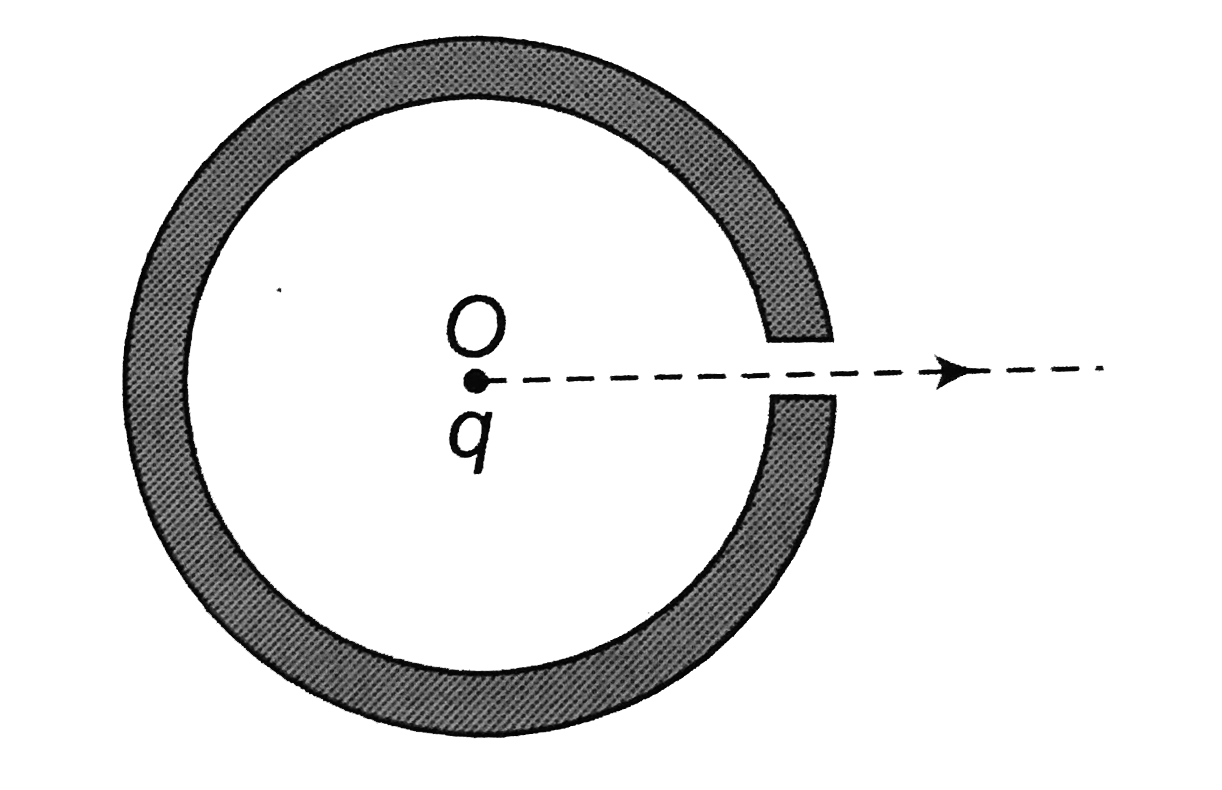A point source of monochromatic light emitting a lumninous flux Φ is positioned at the cnetre of a spherical layer of substance. The inside radius of the layer is a, the outside one is b. The coefficient of linear absorption of the substance is equal to x, the reflection coefficient of the surfcaes is equal to ρ. Neglecting the secondary reflections, find the intensity of light taht passes through that layer.
We have to derive the law of decrease of intensity in an absorbing medium taking in to account the natural geometrical fall-off (inverse sequare law) as well as absorption.
Consider a thin sperical sheel of thickness dx and internal radius x. Let I(x) and I(x+dx) be the intersities at the inner and outer surfcaes of this shell.
Then 4πx2I(x)e−χdx=4π(x+dx)2I(x+dx)
Except for the factor e−χdx this is the usual equation. we rewrite this as
x2I(x)=I(x+dx)(x+dx)2(1+χdx)
=(1+dIdxdx)(x2+2xdx)(1+χdx)
or x2dIdx+χx2I+2xI=0
Hence ddx(x2I)+χ(x2I)=0
so x2I=Ce−χx
where C is a constant of intergration.
In our case we apply this equation for a≤x≤b
For c≤a the usual inverse square law gives
I(a)=Φ4πa2
Hence C=Φ4πeχa
and I(b)=Φ4πb2e−χ(b−a)
This does not take into account reflection. When we do that we get
I(b)=Φ4πb2(1−ρ)2e−χ(b−a)
Topper's Solved these Questions
- BOOK - IE IRODOV, LA SENA & SS KROTOVCHAPTER - OPTICSEXERCISE - Optics Of Moving Sources22videos
OPTICS
- BOOK - IE IRODOV, LA SENA & SS KROTOVCHAPTER - OPTICSEXERCISE - Thermal Equation47videos
OPTICS
- BOOK - IE IRODOV, LA SENA & SS KROTOVCHAPTER - OPTICSEXERCISE - Polarization Of Light43videos
OPTICS
- BOOK - IE IRODOV, LA SENA & SS KROTOVCHAPTER - MECHANICSEXERCISE - Mechanics Problems92videos
MECHANICS
- BOOK - IE IRODOV, LA SENA & SS KROTOVCHAPTER - OSCILLATIONS AND WAVESEXERCISE - Electromagnetic Waves, Radiation36videos
OSCILLATIONS AND WAVES
Similar Questions
A point light soure is in the centre of a spherical layer of a substance, with an internal raiousr1 and an exter- nal radius r2. The refractive index and the absorption coef- ficient of the substance are known. Find the transmittance of the layer of substance. Neglect secondary reflec- tions.
View SolutionA beam of monichromatic light falls normally on the surfcae of a plane-parallel plate of thickness l. The absorption coefficient of the substance the plate is made of varies linearly along the normal to its surfcae from x1 to x2. The coefficient of reflection at each surface of the plate is equal to ρ. Neglecting the secondary reflections, find the transmission coefficient of such a plate.
View Solution
Knowledge Check
- Question 1 - Select One
A point charge q is located at the centre of the spherical layers of uniform isotropic dielectric with relative permitivity K.The inside radius of the layer is equal to a and the outside radius is equal to b.The electrostatic energy inside the dielectirc layer is
A14πε0q22K2(1a−1b)B14πε0q2K2(1a−1b)C14πε0q22K2(1b+1a)D14πε0q2K2(2b−1a) - Question 2 - Select One
A source of light is said to be monochromatic if it will emit light waves of
Asame wavelengthsBdiffererent wavelengthsCdecreasing wavelenghtsDincreasing wavelngths
A point charge q=3.0m,uC is located at the centre of a spherical layer of uniform isotropic dielectric with permittivity ε=3.0. The inside radius of the layer is equal to a=250mm, the outside radius is b=500mm. Find the electrostatic energy inside the dielectric layer.
View SolutionA point source of light is placed at the centre of curvature of a hemispherical surface. The radius of curvature is r and the inner surface is completely reflecting. Find the force on the hemisphere due to the light falling on its if the source emits a power W.
View SolutionA point source of light is placed at the centre of curvature of a hemispherical surface. The radius of curvature is r and the inner surface is completely reflecting. Find the force on the hemisphere due to the light falling on its if the source emits a power W.
View SolutionNatural light falls at the Brewster angle on the surfcae of glass. Using the Fresnel equations, find
(a) the reflection coefficient,
(b) the degree of polarization of refracted light.View SolutionA beam of monochromatic light passes through a pile of N=5 identical plane-parallel glass plates each of thickness l=0.50cm. The coefficient of reflection at each surface of the plates is ρ=0.050. The ratio of the intensity of light transmitted through the pile of plates to the intensity of incident light is τ=0.55 Neglecting the secondary reflections of light, find the absorption coefficient of the given glass.
View SolutionA point charge q is located at the centre O of a spherical uncharged coducting layer provided with small orifice. The inside and outside radii of the layer are equal to a and b respectively. The amount of work that has to be performed to slowly transfer the charge q from teh point O through the orifice and into infinity is
 View Solution
View Solution

